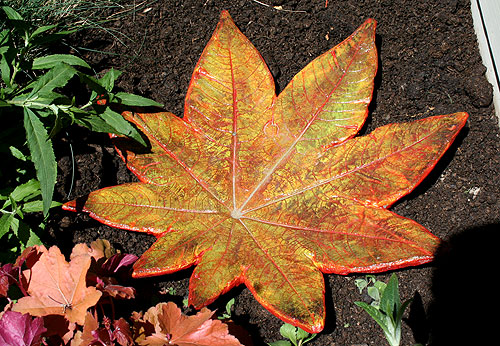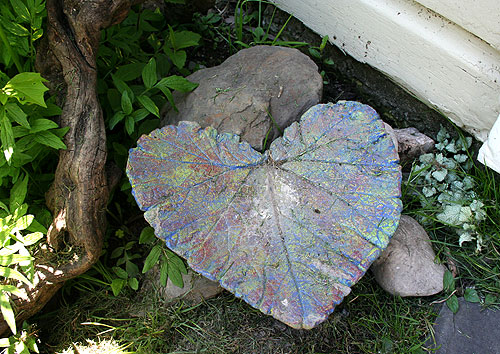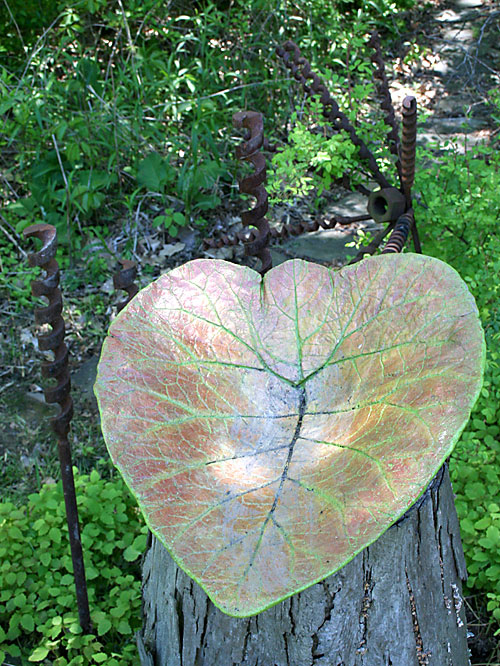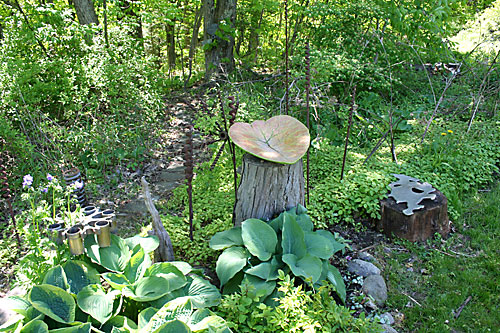First I read an uninspiring article in the May/June Fine Gardening (Leaves that last forever).
Then there was Susan’s rant over at Garden Rant (“Quick and easy” concrete leaf castings? You’re kidding, right?) where she wrote: “I’ve produced more than a fool’s share of castings that break, and an even larger number that just look like crap.”
Well let me let you in on a little secret: Vinyl patio patch. You can find it wherever fine construction supplies are sold.
Yes, straight concrete is not strong enough to make delicate leaf casts. But the additives in patio patch make it easier to work with thin and are not nearly so prone to breaking after they are fully cured. If you get the mix at the correct consistency, you don’t get the oozing over the edges that Susan complains about. And what little does ooze over is not difficult to file off.
The patio patch tip came to me from my sister-in-laws boyfriend Marc. (Did I mention his wooden bowls and sculptures make great gifts, and you can order online?) He picked up the technique at an art show where he got to know a woman who makes these for a living. No way would she try to use straight concrete for such a project.
Granted, Marc’s pieces here show his knack for working in three dimensions. My attempts aren’t nearly as good. (Sorry, no pictures handy. Look for a very serviceable bird bath in the yard now from an elephant ear leaf cast in pictures later this summer.) But they beat the heck out of any I’ve tried to do with straight concrete.
Here’s Marc’s elephant ear leaf cast:






I have seen Marc’s work. He is a skilled craftsman and that is the secret. Not everyone can do this kind of work. Thanks to bead shops, a lot of my friends now consider themselves jewelry makers, but if you do not have the artist’s instinct, access to supplies isn’t going to help. (Just my two cents.) If Marc brings some leaf casts to Allentown this year (if he is coming) I will buy one. That will be my secret method.
Hi Elizabeth:
You wouldn’t turn a beginning gardener loose with a snow shovel to turn over their beds. So you shouldn’t tell folks to go make leaf casts with regular old concrete.
This is a project that even those of us who struggled to keep the crayon between the lines can turn out decent work — if we use the right materials. Sure, people like Marc are going to crank out better pieces faster than the rest of us. But that’s no reason why the rest of us shouldn’t give this project a try.
Hi Craig,
A fellow blogger referred me to your site and I’m really enjoying it! I especially liked the tip about leaf casting. I just posted about my own experiences doing such a project, and although we got great results, I love to improve on my technique. We do the “paint it black and rub metallic pigment” look on most of our leaves…either that, or just straight acrylic paint, sealed afterwards. I’m not sure what Little & Lewis do to make their leaves that intense glow-in-the-dark color. What is your painting technique? Acrylic? Have you mixed in pigment into the mixture before you cast? Check out our efforts here: http://www.cindydyer.wordpress.com.
I’ve linked to you to my blogroll; hope you don’t mind!
Cindy
Oh, excellent. I’ve seen some cool leaf castings, but I was discouraged by the blog posts I’d read about using straight concrete. I’m definitely going to have to try this vinyl patch technique. Let’s hope that it’s not too late for me to plant some castor beans!
Is there a name for the vinyl patio patch? I can’t find it at the lumber yard.
Hi Debbie:
Quikrete — one of the most common brands — makes a vinyl formulation:
http://www.lowes.com/lowes/lkn?action=productDetail&productId=10397-286-14407&lpage=none
Hi, I started making leaf castings quite by accident, a customer asked me to design her a tropical water feature, so I opened a freebie magizine I received, and low and behold there was a leaf casting of a rubarb leaf bird bath, I said huh, why cant I put a hole in one and make a three tier water feature. So I did. I use Type S quickcrete mortor mix. I don’t have a problem with breakage AT ALL!. I cast them in the morning and turn them out the next day (the extra large ones I let sit 2 days, 3 to 4 ft ones). I have only cracked 2 of the 30 or so that I have made thus far and that was my husbands fault (he said I could turn them out after about 4 hours!!). The smaller leaves (8 to 15 inches) I dont use any reinforment on. The larger ones 2 to 4 ft I do 2 layers, after the first layer I use fiberglass wall tape, pat pat to bring cream up to the surface (this also helps to reduce the air bubble holes left after you turn them out) and then add another layer of mortor. I also don’t bring the mortor to the edge of the leaf. After the second layer of mortor I pat pat pat to bring the cream to the top and while I am patting I put my hand on the edge and pat it down to about 1/8 from the edge. As it is drying it will sloop a bit but pretty much stays at the edge, where it went over, I use a dremel to grind the edge to smooth it out. Also, don’t make it too wet. I make mine like thick mashed potatoes or peanut butter. Still a bit on the dry side, but moist enough that when you grab a handful it stays together. I keep a spray bottle handy, and spritz a bit on what I applied (VERY LITTLE BIT) if it seems to dry. SO, I have that part down pat (no pun intended LOL) I let them sit for a week or so, then prime and paint with the acrylic paint. My problem is the sealer. I have read over and over to use Krylon or rustoleum spray acrylic sealer (exterior). This looks great but I am getting peeling. What I am doing wrong I dont know. Maybe someone can recommend something to me? preferably paint on as I live near water and we get quite a breeze and I loose a lot when I spray. My paint is cracking and peeling! Can someone help?
Sorry this was so long.
I think if your paint is cracking, it might be that you are not letting the concrete cure long enough — you should wait at least 30 days before painting. Also, I don’t seal the bottom of my leaves as I would like them to breathe. The only tip I might add to these comments is that when I cast leaves on an old wooden table, I trace the leaf with chalk, remove it, then make my sand mold, being careful to stay well within my chalk boundaries. You really want enough of the leaf laying flat to help prevent the concrete from going off the leaf. With this method, I don’t need to cover the sand mold with plastic. When I am finished with my leaves, I cover the whole table with plastic and let is sit a good 3 or 4 days before moving them around much. Ok, I peak at day two. Also, using a cooking oil spray on pouruos leaves will help them peel away easily. http://www.morningwoodfarm.com/leaf/gallery.htm . David
Hi – I am wanting to try these great leaf castings. I am confused about the vinyl patch – do you use just the past or mix it with the concrete? I just bought a back of concrete today, so I can return it if I can figure out what I need to do. Also, what is the painting technique you use? So vibrant and gorgeous. Any help would be greatly appreciated. THanks! Laurie
Laurie, I add the adhesive to my wet concrete mixture. As for the colors, I usually start out with a mixture of 2 parts water and one part acrllic paint and completely cover the entire piece. I then start layering more colors over top. I finish off with touching up with undiluted paint. I use both brushes and sponges to apply the paint.
Leaf Casts
I have been working with concrete leaf casts for about a year and lately it seems they are all cracking during curing. I have been spraying them with water during curing and getting the inital concreate to about a brownie consistency-what gives???
Help!!!
can you tell me the technique you use to apply the powdered pigments. I tried a paint brush, sponge brush and my finger and can’t seem to get good coverage. Also what colors did you use on your castor bean leaf cast on your website? It is absolutely stunning!
hi – just wondering if you could let me know what kind of sealer do you use? thanks a bunch. sue
I have been reading your comments. I am wondering if anyone knows how to keep leafs to do in the future. I am also getting brown shops from some of my leafs and I don’t know how to handle when the leaf get caught under the cement. I get holes along the edge. I hope someone can help me. vlearly@aol.com
Your write-up has confirmed useful to myself.
It’s very educational and you’re simply clearly very well-informed in this region. You possess popped my personal eyes in order to varying opinion of this kind of subject matter with intriguing and reliable articles.
I use Mortar mix and like it better than the Concrete only because of the stones in Concrete. I like the finish better. I have use vinul concrete patcher also. It is a little pricier. I have not had to much problem with breakage.
I love doing these leaves. My retirement fun thing!!
I use 1 part Portland Cement to 3 parts sand and 1 part water, more or less. I also use 1/4 part acrylic concrete fortifier in the water. It makes the concrete a little more “plastic” and easier to work with. You can also add a handful of reinforcement fibers.
To keep the concrete from getting under the leaf, leave about 1/8″ of leaf edge showing.@Vicki:
I like the powdered pigments, too. I apply them with a soft rag after the leaf has fully cured and been painted a dark color.@Beth:
@Laurie Gilson: yes can you give me the recipe for using the vinyl patch? do you add sand AND concrete to it or do you just use it by itself?
@David: oops David can you answer this?
can you give me the recipe for using the vinyl patch? do you add sand AND concrete to it or do you just use it by itself? a little confused! I’ve been using 1 part portland cement to 1 part sand….that works good but if the vinyl patch is not as heavy that would be great too!
anyone have the recipe for leaf casting with the vinyl patch? Do you just use it by itself or add sand?
When using the vinyl concrete, you only need to add water to it. It is very simple and much less messy than dealing with concrete alone. I was also told by the Lowe’s employee (take it at face value) that you do not need to seal it. I am doing my first project using it (concrete ball planter) so I will let you now how it turns out.
How are the vinyl concrete leaves turning out? My friend and myself have just started working on leaves for a December craft show and are wondering vinyl or portland. Thanks
Love the rhubarb leaf planters…does anyone know where I can get a mold for these or any large leaf planters (not stepping stones). We live in Florida and don’t have access to rhubarb plants!
I have recently been using QUIKRETE Vinyl Concrete Patcher (contains portland cement, fine sand and vinyl resin) to make good looking leaf castings (gunnera and pumpkin). It comes in 20-lb bucket for $8.78 (I purchased @ Lowe’s). Just add water per instructions on label. MUCH easier than separately purchasing and mixing cement, sand, etc.
@Craig: I made my first leaf out of quik-qrete….talk about hard, but it can be done….
I LOVED EVERY BIT OF THIS ARTICLE AND COMMENTS!! I just retired and just had my first epic failure in cement. Ok, I am reading everying I can and will try again.
Thanks for all of your information, pictures and comments. I am on a new adventure and will keep at it until I can make plant pot and leaf castings!!
TIA, Penny
Wow…I guess had I started reading this before I made some casting, I probably would not have tried. I like uncomplicated things!
I planted elephant ears where they will be trampled when we rebuild our home and knowing I have to dig them up and relocate, I decided I would cut the leaves off and cast them to make a water feature later.
I had a fresh bag of concrete and even some brown pigment dye so I just poured some in a bucket, added about 1/4 of the dye and just enough water to clump, then a little more.
I turned the leaf over and patted the concrete down. I let them sit about half the day then peeled off the leaf to let them further dry. They all came out great with no breaking. The top side is detailed and does not show the rocks but the underside does. I only let cure a week before spraying krylon clear coat. To me, they turned out great.
Next, I want to try painting methods!
Okay, I use 2 gallons portland cement, 4 cups motar, 4 cups vermalite and 1 cup liquid concrete bond (mix with 1 quart of water) and 2 quarts of fine peat moss. Add water until it gets to a nice mud pie ball. I also finish with Triple Thick Glaze by Rustoleum. The premix Quickcrete vinyl patch is perfect but very expensive. The above recipe might give you a medium leaf. I also bought a rubbermaid tote and I premix all my dry in bulk and just take out a couple large containers of dry mix and add my liquid bond and water and get to making my leaves.
Sure wish I could share some of my leaves on here. I dry brush alot in layers like i did with my ceramics and porcelins.
Some of these are very old posts. Can I purchase these from anyone? I am looking for the three cascading leaves for a downspout.
I don’t think
I’m up for making these on my own.
I used the Quik Crete vinyl patch yesterday and in a rush, trying to cover it because of rain, I accidentally broke the very point of the leaf casting. I discovered the crack this morning after it had dried for 24 hours. Any thoughts as how I might repair this?